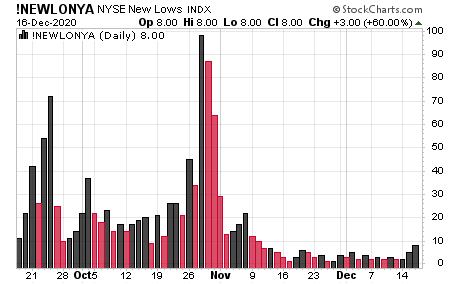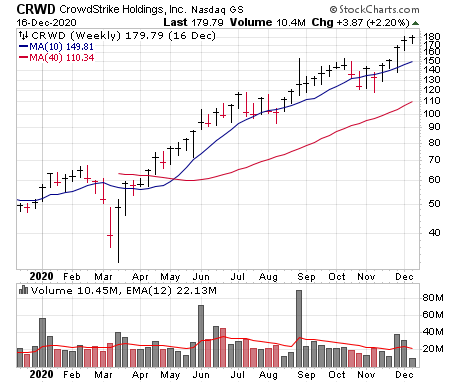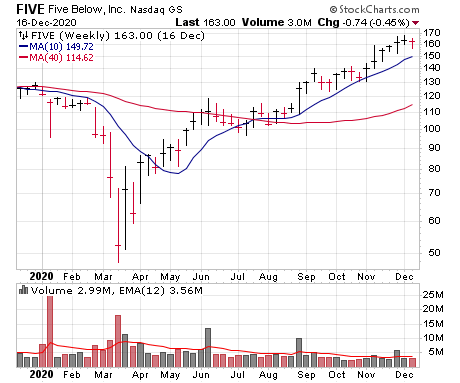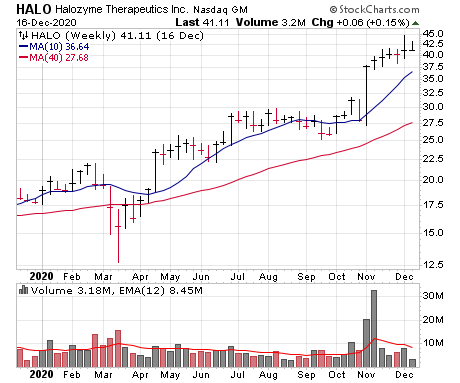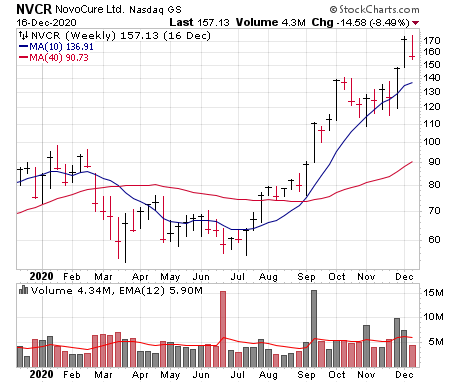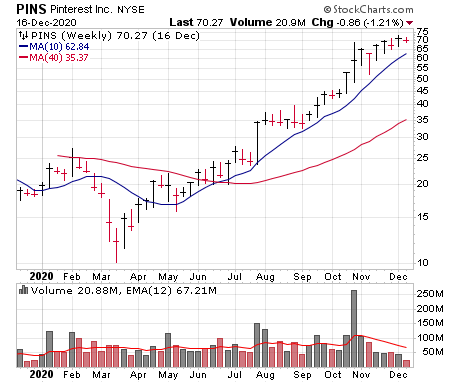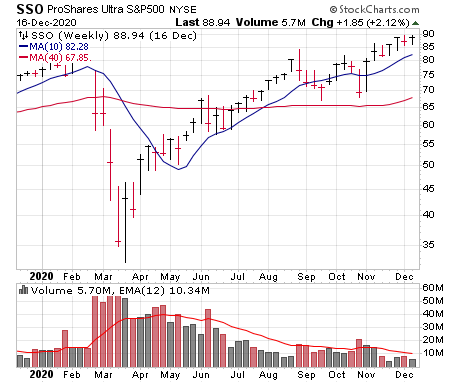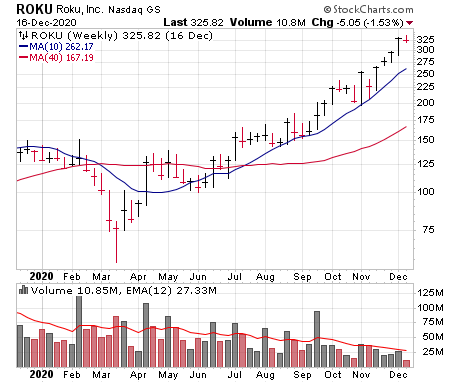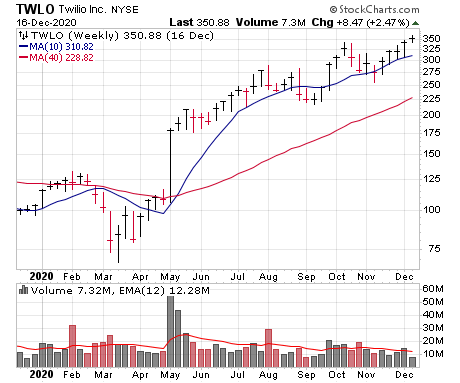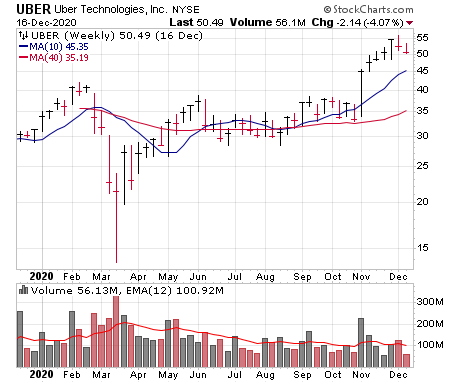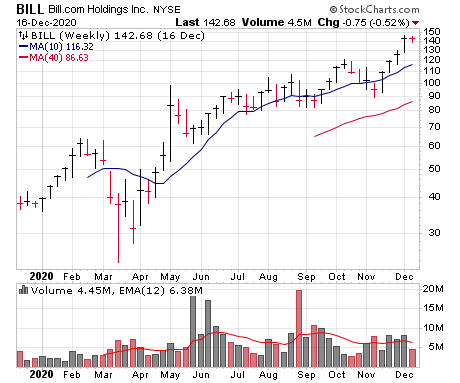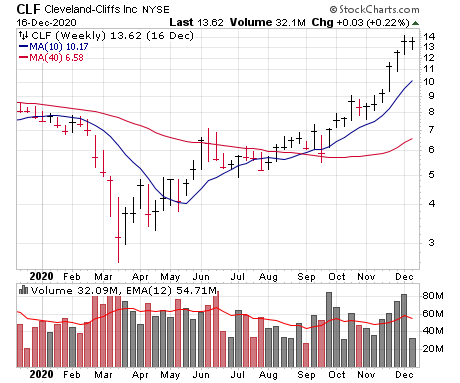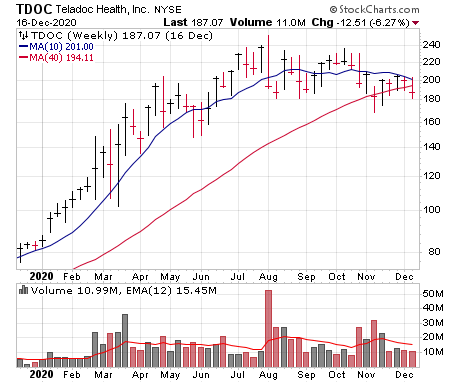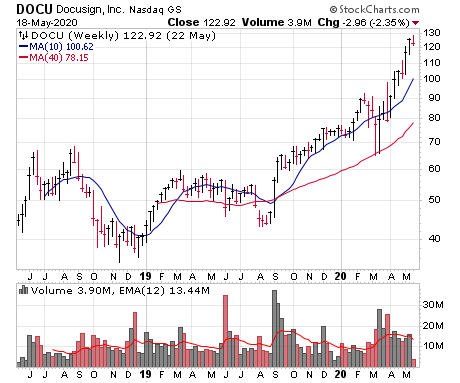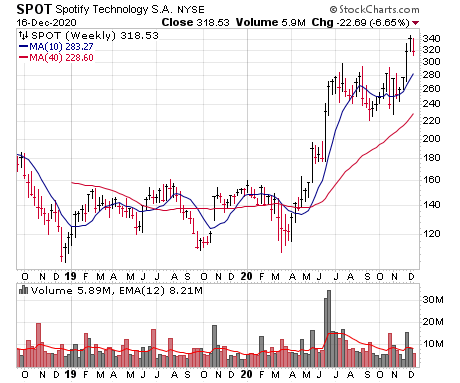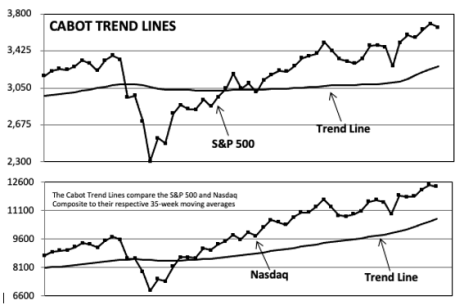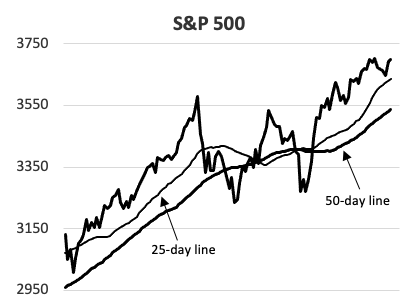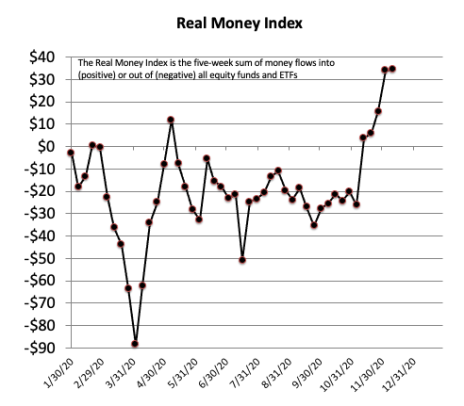The evidence remains mostly bullish, with the major indexes and a growing number of leading stocks acting well. To be fair, it’s not 1999 out there, as many stocks are suffering a lot of choppy action and sentiment is buoyant--that’s no reason to be negative, but we’re continuing with our step-by-step buying spree.
Last week, we started a new half position in CrowdStrike (CRWD), and tonight, we’re filling out our position in Novocure (NVCR), leaving us with around 20% in cash.
Cabot Growth Investor 1461
[premium_html_toc post_id="221911"]
Into the Homestretch
We’re past the halfway point in December, which means many of us have other things on our minds, be it getting out the snow shovel (a foot of snow hit the ground here last night), buying last-minute gifts or perfecting your favorite eggnog-based drink. We hope you and yours have a wonderful holiday season.
As for the market, not much has changed with the evidence: When it comes to rubber-meets-the-road things like the trends of the major indexes, the price/volume action of leading stocks and the amount of abnormal action out there (very little), there’s no question the bulls are in control.
And, as opposed to periods this year, much of the secondary evidence looks great, too. Check out this chart of our old Two-Second Indicator—the number of stocks hitting new lows on the NYSE has come in at 10 or less for 27 straight trading days, a strong sign that the sellers just aren’t able to make any real headway. It’s a similar story with the new lows on the Nasdaq, too, while other secondary measures we look at (like our Aggression Index) are also encouraging.
On the flip side, sentiment is still something we’re watching closely. Six months ago, when the economy was in tatters and there was little clarity on a vaccine, most were bearish despite the buoyant action in growth stocks. Now, at much higher prices, most are bullish as the news has turned encouraging. We know the market serves to trick the majority, so some late-December or early-January shenanigans wouldn’t shock us.
Plus, we’re still seeing lots of on-again, off-again action in growth stocks. Don’t get us wrong, the overall action is solid, and we’re happy to be holding what we think are many early-stage leaders in the Model Portfolio. But there’s plenty of chop out there, with gains coming in short bursts followed by lots of up-down action after that.
Still, we don’t see the sentiment and chop factors as reasons to grow cautious. Instead, they’re reasons to adjust how to go about being bullish—in our case, we’ve been steadily stepping into the market over time (instead of all at once) as opportunities emerge, though have usually been starting with smaller (half-sized) positions in case a market-wide air pocket emerges or a stock bites the dust.
What To Do Now
Unless something drastic changes, we’re going to continue with that plan as we head into the New Year. Last week, we started a new half-sized position in CrowdStrike (CRWD), and in today’s issue, we’re going to fill out our stake in NovoCure (NVCR) by purchasing another half. That will leave us with around 20% in cash.
Model Portfolio Update
As the market has continued to grind higher, we’ve continued to slowly put money to work, buying half-sized positions (either new or filling out existing positions), and we’re continuing that today, adding another half-sized stake in Novocure to bring us up to a full position.
As for the rest of our holdings, they’re mostly acting well, but the action is more jagged—many stocks will pop higher for a few days and then chop around for a couple of weeks or more, before again attempting to stretch higher. In other words, it’s more of a two-steps-forward, one-step-back environment for growth stocks, so we favor entering on weakness and giving names room to breathe.
With just a couple of weeks of market action left this year, we’re not in a rush to push the envelope as we hope to cap off what’s been a great year for the portfolio (thank you Santa), but we won’t hesitate to pull the trigger (buy or sell) if something comes up. In the meantime, Happy Holidays!
Current Recommendations
| Stock | No. of Shares | Portfolio Weightings | Price Bought | Date Bought | Price on 12/17/20 | Profit | Rating |
| CrowdStrike | 567 | 5% | 175 | 12/11/20 | 185 | 6% | Buy a Half |
| Five Below (FIVE) | 1277 | 10% | 138 | 9/18/20 | 163 | 18% | Buy |
| Halozyme (HALO) | 2339 | 5% | 41 | 11/27/20 | 42 | 4% | Buy a Half |
| NovoCure (NVCR) | 714 | 6% | 125 | 11/6/20 | 160 | 27% | Buy a Half |
| Pinterest (PINS) | 2962 | 10% | 40 | 9/18/20 | 71 | 79% | Buy |
| ProShares Ultra S&P 500 (SSO) | 1,741 | 8% | 60 | 5/29/20 | 90 | 49% | Buy |
| Roku (ROKU) | 901 | 14% | 170 | 8/28/20 | 337 | 99% | Buy |
| Twilio (TWLO) | 553 | 9% | 174 | 5/8/20 | 363 | 109% | Buy |
| Uber (UBER) | 3,656 | 9% | 52 | 11/20/20 | 51 | -2% | Buy |
| CASH | $482,242 | 24% |
CrowdStrike (CRWD)—There are many good-looking names in the new-age cybersecurity space—including Okta (OKTA), which we’ve made money with a couple of times—but CRWD is our pick of the litter right now, as we think it has emerging blue chip written all over it. Indeed, management is thinking big, believing the company’s Falcon platform could be similar to the platforms of Salesforce.com (customer relationship), ServiceNow (in operations) and Workday (human resources)—i.e., a key back-office service that tens of thousands of firms (especially big, global ones) will become reliant on in years to come. And because the firm sells mostly via subscriptions, that means recurring revenue (up north of 80% in Q3) and earnings should kite higher from here. As for the stock, it’s shown excellent strength since earnings, and while it’s had a big run from its pandemic lows in March, shares just emerged from a huge post-IPO base in August. We bought a half-sized stake (5% of the portfolio) last week. BUY A HALF.
Five Below (FIVE)—After a smooth run that began in early November, FIVE has hit a little resistance, seeing some above-average volume selling before bouncing off its 25-day line yesterday. FIVE isn’t a go-go stock, so a rest/pullback here seems normal to us, and fundamentally, all systems are go after the most recent quarterly report—despite the pandemic, the firm’s store count ended October at 1,018, up 14% from a year ago, while same-store sales growth of 12.8% crushed views. And, while they gave no explicit guidance, management sounded an optimistic tone for Q4, both sales-wise and just how the company is positioned (inventory is down 10% on a per-store basis vs. last year, while Five Below has zero debt). Back to the bigger picture, more investors are coming around to the view that Five Below’s best-in-class cookie-cutter retail story is back on track and added e-commerce capabilities (new tech platform; same day delivery from about 300 stores thanks to a recent deal with Instacart) may even goose the prior growth track. We continue to think the path of least resistance is up—hold on if you own some, and if not, we ‘re fine buying some here or on retreats. BUY.
Halozyme (HALO)—Halozyme has been quiet on the news wires since it inked a deal with Horizon Therapeutics last month, but that hasn’t stopped it from jumping around on a day-to-day basis, including a wild intraday reversal last week. Even so, the overall trend remains strongly up and the stock really hasn’t left its give-or-take 40 range that it’s occupied for a few weeks. Of course, there’s always the chance that growth stocks keel over and HALO falls by the wayside—a drop to 34 or so (below the 50-day line and the top of a breakaway gap) could have us pulling the plug on our half position. But right here, we remain optimistic that the firm’s unique growth story and burgeoning sales and earnings ($2 per share next year isn’t out of the realm of possibility) means the next big move is up. We’d like to see a bit more strength before filling out our position, but we’re fine buying a half-sized stake (5% of the portfolio in our parlance) here. BUY A HALF.
NovoCure (NVCR)—NVCR has finally hit a pothole, pulling back a quick 20 points after the 50-point rise ahead of that. Frankly, we wouldn’t be surprised to this retreat last longer or go further, but given the firm’s solid story (addressable market should grow many-fold over the next two to three years), numbers (profitable and expanding bottom line in 2021) and early-stage chart (it just emerged from a year-long base in September), we’re going to buy the dip, filling out our stake by adding another half-sized (5% of the portfolio) position. Fundamentally, there continues to be positive news—Switzerland, for instance, just approved reimbursement for the firm’s Optune treatment for glioblastoma. And, while it’s not confirmed they’ll be there, any update from management at JP Morgan’s early-January healthcare conference could help perception. Volatility here (in both directions) will be extreme, but barring something unforeseen, we think NVCR is likely in the early-ish stages of a new, sustained run. BUY ANOTHER HALF.
Pinterest (PINS)—Bigger picture, nothing has changed regarding our thoughts with Pinterest—if things fall into place, we think the stock’s initial breakout from a big post-IPO base in September and its one-of-a-kind, idea-generating e-commerce website (my wife has been using Pinterest for ideas on what to do each night with our Elf on the Shelf!) will make this a must-own stock among institutional investors. To be fair, PINS has lost some upside power—despite the market advance, PINS has been churning near the 70 area for three weeks. That’s hardly a death knell (volume has really dried up, so it’s not like there are many sellers out there), and we’re more than willing to give PINS plenty of room to maneuver. Near term though, the stock is a bit of a tossup, so if you’re starting a new position, we’d suggest either going with a small stake or aiming for dips of three or four points. BUY.
ProShares Ultra S&P 500 Fund (SSO)—At some point, the major indexes (and, hence, SSO) will hit an air pocket given the elevated sentiment, but you don’t want to focus on the trees and lose sight of the forest. The showings of unusual strength and breadth over the past month almost always leads to good things down the road, and the S&P “just” got going in early November (part of a larger eight-month base from the February highs), and usually these upmoves last longer than a month and a half before the big investors are done buying. Throw in the fact that SSO continues to act well (holding above its 25-day line since the election) and the odds still favor higher prices ahead. If you don’t own any, we’re fine grabbing shares here or on a dip of a couple of points. BUY.
Roku (ROKU)—ROKU remains in a steep uptrend as big investors are thinking 2021 could be the year that major advertisers really, truly recalibrate their budgets, directing more money toward streaming services and platforms (so-called connected TV). Interestingly, the news that supposedly kicked off ROKU’s recent advance (that HBO’s streaming service was likely coming to Roku’s platform) has finally been confirmed, and we’ll be keeping our eyes open on how negotiations for other services (Discovery+ is going live in early January but they’re still negotiating with Roku) proceed. As we wrote in last week’s update, ROKU is extended (50-day line is down near 250) and the recent rally has come on light volume, so if the advance accelerates from here, we may consider taking partial profits. Right now, though, we’re not overthinking it—we’re sitting tight with our position, and if not yet in, you could buy some, preferably on dips. BUY.
Twilio (TWLO)—TWLO has stretched to new price highs since we restored our Buy rating last week. Of course, it’s not a perfect picture—the relative performance (RP) line has only barely eked out a new high and volume on the breakout was just OK, both of which might mean TWLO gyrates in the near term. But we’re thinking the past four-plus months represented a normal (albeit tedious) consolidation after the prior advance, and now the sellers have been worn out. One thing big investors will be keying off is how the integration of Segment is going, which the company bought for north of $3 billion in October—the purchase gave Twilio a stake in the $17 billion customer data platform space, which involves using multiple tools and data to build a database of potential customers, hence allowing for more personalized (and effective) marketing campaigns. Twilio can also sell these firms cloud-based call center solutions and generalized, automated communications, too, with its other core offerings. Back to the stock, we still see TWLO as a liquid leader of the overall bull move—we’ll stay on Buy. BUY.
Uber (UBER)—UBER hit some resistance in the mid 50s and has softened a bit since then, likely due to both a $1 billion convertible (dilutive) note offering, as well as the IPO of Doordash (a competitor to Uber Eats), which (a) often causes money to slosh back and forth between the two companies for a bit, and (b) cause investors to focus on the downside of competition. But following the recent advance, this pullback looks more than reasonable, and fundamentally, there’s no question Uber is the leader in both name recognition and size when it comes to Rides and Delivery, both of which should grow nicely in the quarters ahead. A drop into the low 40s would have us changing our tune, but right here, we think UBER is near a good entry point if you’re not yet in. BUY.
Watch List
- Bill.com (BILL 145.86): We’ve been following BILL off and on for a while now, and it finally seems to have grown up and begun a sustained move. See more below.
- Spotify (SPOT 327.98): We went to the well once with SPOT and it didn’t work out, but that may have just been a timing issue—the stock came back to life during the past couple of weeks and is holding its recent breakout. See more later in this issue.
- Zillow (Z 138.45): Z and some other housing stocks (like Floor & Décor (FND)) have perked up of late, possibly starting the next leg up of their overall advances.
Other Stocks of Interest
Bill.com (BILL 145.86)—We’ve been keeping a loose eye on Bill.com for many months, as it has a powerful, easy-to-understand growth story that should take it far in the years ahead: The company’s cloud platform is aimed directly at small businesses (those with between 2 and 500 employees), taking these firms out of the stone age (90%-plus still process invoices, bills, contracts, forms and the like on paper) and into the digital age by allowing them to easily send and receive payments online and sync to most big accounting and banking systems. To us, Bill.com looks like the next leader in the mega-theme of helping small businesses do more online (Shopify and Square were two others), and having captured just 2% of its target market (six million businesses are potential customers), there should be years of rapid, reliable growth ahead. Granted, there have been some near-term hiccups as Bill’s small-firm client base has been impacted by the shut-ins, but even that hasn’t hurt growth much—in the most recent quarter, so-called core (subscription and transaction-related) revenue advanced 53%, customers numbered 103,000 (up 27%) and total payment volume also rose 27%. The story and numbers have been great ever since the company came public late last year, but what’s stopped us from stepping in has been the stock—its performance has been decent but very hectic, with the stock and RP line having a hard time getting a head of steam going since May. But now BILL may be growing up as more funds (359 owned shares at the end of September, up from 192 at year-end 2019) take a position—shares have moved decisively to new highs on three straight above-average volume weeks. A modest pullback could have us taking a swing at it.
Cleveland-Cliffs (CLF 13.92)—There’s been a bit of sell-the-news action in metals and cyclical areas in recent days following the official start of the virus vaccination, but we’re thinking the kickoff in these types of names (which comes after three years of sad performance) is likely to carry on. One pure play to keep an eye on is Cleveland-Cliffs, which has long been North America’s largest producer of iron ore pellets (one of the key inputs in steel), making it a straightforward play on a rebounding economy (and potentially inflation) in 2021. But what we find most intriguing is that Cliffs has actually been on the offensive, buying low during the past year while most were hunkering down and cutting back—the firm completed the acquisition of AK Steel in the second quarter of this year (a natural fit, creating a vertically integrated steel operation), and then just this month, completed the purchase of ArcelorMittal USA (another good-sized steel maker), positioning the company as one of the key input providers to many key industries (especially automotive, which made up 73% of sales in Q3) in the U.S.! Those buyouts now appear perfectly timed, and when combined with synergies, could result in a booming bottom line—even as things restarted in Q3, Cliffs was profitable and cranked out nearly 50 cents per share of free cash flow. And there’s likely a lot more where that came from, with output (and likely prices) headed much higher in 2021; analysts see earnings of $1.75 per share next year (free cash flow much bigger than that), which could prove conservative. Not surprisingly, CLF has been red hot, breaking out of a base in October and levitating to 14 on accelerating volume. In most cases, the first pullback of a week or two after such a show of power proves buyable. If you’re interested, keep a lookout for that.
Teladoc Health (TDOC 196.89)—We took a big profit in TDOC earlier this year because the outsized selling pressure following a massive run and the announced buyout of Livongo told us the trend had changed—and indeed, the stock hasn’t made any progress four-plus months later despite an up market. Still, we never thought the stock was completely done for, both because of the chart (it just broke out from a 15-month zone in January of this year) and the fundamentals—Teladoc is still the gold standard in virtual care (yes, in spite of news that Amazon is trying to enter the market), a service that’s hit the mainstream thanks to the pandemic. It’s the leader in the field of connecting doctors to patients, often for routine reasons like the sniffles or a bug, but increasingly for areas like mental health, which unfortunately is a big growth area. And, thanks to its acquisition of InTouch Health, it’s also the leader for virtual care within hospitals (think doctor-to-doctor consults), while the buyout of Livongo gives it a presence in the fast-growing field of full service health help, including monitoring, 24/7 support and even “nudges” to make sure you’re following through on your health plan. (It’s already seeing a lot of cross-sell interest from its client base for Livongo’s services.) The underlying business has remained red hot this year—in Q3, revenues were up 109% while total virtual visits more than tripled and subscribers topped 73 million (including 51.5 million U.S. subscriptions, up 47%, and 21.8 million pay-per-visit members, up 15% from a year ago). Looking ahead, the company (and Wall Street) expect sustained 30%-ish organic growth for years to come as virtual care becomes included in more and more health plans. The question, though, is the stock: It’s now spent about four and a half months building a double-bottom base, and while it’s not buyable here, any upcoming catalyst (the JPMorgan Healthcare conference in early January often makes headlines; after that comes earnings in early February) could do the trick. TDOC is worth keeping on your “back burner” watch list—it still needs work, but after months of rest, it may be getting close to resuming its major advance.
Timing is Everything in the Market
In the long run, owning stocks with top notch stories and numbers is vital to success—if you’re just chasing whatever chart looks nice today, you’ll end up being whipped around. Growth that’s rapid, reliable and has a long runway ahead of it (we call that the Three R’s) is the juice that attracts hundreds of big investors.
However, where charts come into play is with timing—by identifying when perception of a firm’s future changes for the better (to buy) or worse (to sell). DocuSign (DOCU) was a good example—the story and numbers were consistently great, but the stock lagged badly for about 15 months in 2018 and 2019. It wasn’t until DOCU flashed decisive upside power around Labor Day (two huge-volume weeks of advance on the breakout, which we call Double Skyscrapers) of last year that we got in and DOCU began its great advance.
One thing running through our mind is whether Spotify (SPOT) is in a similar situation today. In this case, the stock decisively broke out in June of this year (like DOCU, in fact, it sported Double Skyscrapers on the weekly chart), and we took a stab at it in August after a bounce off the 50-day line. But the timing was off—SPOT needed more of a rest to consolidate its huge prior gains, which is exactly what it did for the following three months, gyrating up and down despite the higher market.
But now it appears that the stock’s major upmove is back on: Earlier this month, SPOT clearly broke out again on big volume on no particular news and it’s held those gains since. In terms of the fundamentals, we wouldn’t say the story or numbers are perfectly pristine here—Spotify has solid but not spectacular growth (in the 20%-plus range), and there’s plenty of competition, too—but there’s no question the firm is the leader, especially in the fast-growing podcast field (Prince Harry and Meghan have recently signed up to do one!), which is already attracting new subscribers, opening up new advertising avenues and making its user base stick around longer. All in all, we’re intrigued, and SPOT is back on our watch list. WATCH.
Don’t Get Too Close to Your Stocks
One of the more common questions we’ve gotten this year has been something like “Hey, I see that the S&P 500 and even the Nasdaq are up 1% today, but XYZ and ABC that you have in the Model Portfolio are down—is there something wrong?” Of course, it’s always good to be on top of your stocks, as the worm can turn in a hurry, but most of the time you can do more harm than good by getting too close to your stocks—especially during a rotational environment.
A good example of this comes from Roku (ROKU), a stock we’ve owned for a few months and have done very well with to this point. We randomly decided to look at the past three months of trading and compare its action with the S&P 500 on a day-by-day basis. During this period, there were 64 trading days, and in total, the S&P 500 rallied around 10%, a very solid return for a major index.
What’s interesting is that, during this advance in the S&P 500, ROKU was actually “out of gear” with the S&P quite often. For instance, of the 34 days the S&P 500 was up, Roku was down 12 times (equal to 35% of the time). And overall, ROKU went in the opposite direction of the S&P (up while it was down, or down while the S&P was up) a full 35 times, which translates into a whopping 45% of trading days. Given that the market enjoyed a solid bull move, that could leave you to believe ROKU did poorly—but, of course, it’s been just the opposite, with the stock more than doubling in just these three months!
Leaving aside all the exact numbers, the point here is that, yes, it’s important to look for strong stocks that are generally outperforming the market, but things are rarely as clean in real life as it is in the history books. Once you own a leader, you want to give it a chance unless it trips a mental stop or flashes clearly abnormal action. Getting too close and reading too much into the day-to-day action will often have you seeing mirages.
Cabot Market Timing Indicators
The story remains mostly the same: The primary evidence remains bullish and most stocks are headed up, so we’re staying in a bullish frame of mind. But with sentiment elevated and day-to-day crosscurrents and rotation still in effect, it’s important to proceed gradually and focus on only the best stories and charts.
Cabot Trend Lines: Bullish
Over time, our Cabot Trend Lines have been our most dependable indicator—they don’t give to-the-second buy or sell signals, but they always keep you on the right side of the major trend, and that alone puts you ahead of most investors. Today, the longer-term trend continues to be clearly up, as both the S&P 500 (by 12%) and Nasdaq (by 16%) remain perched well above their respective 35-week moving averages, which is a good reason to stay positive.
Cabot Tides: Bullish
Our Cabot Tides are also in fine shape, with the buying pressures keeping all of the major indexes we track (including the S&P 500; daily chart shown here) in good-looking uptrends above their lower (50-day) moving averages. Better yet, the indexes have about 4% to 5% of daylight above their respective 50-day lines, so the intermediate-term uptrend should be able to withstand any short-term shakeout if the sellers show up.
Cabot Real Money Index: Negative
The Real Money Index continues to hang around a two-year high, which goes along with numerous other sentiment measures that tell us investors have gotten as complacent/excited as they’ve been in a couple of years. That doesn’t necessarily mean the upmove is about to keel over, but it does imply that risk has risen, so stepping into stocks at logical entry points is a must.
Charts courtesy of StockCharts.com
The next Cabot Growth Investor issue will be published on December 31, 2020.
Cabot Wealth Network
Publishing independent investment advice since 1970.
CEO & Chief Investment Strategist: Timothy Lutts
President & Publisher: Ed Coburn
176 North Street, PO Box 2049, Salem, MA 01970 USA
800-326-8826 | support@cabotwealth.com | CabotWealth.com
Copyright © 2020. All rights reserved. Copying or electronic transmission of this information is a violation of copyright law. For the protection of our subscribers, copyright violations will result in immediate termination of all subscriptions without refund. No Conflicts: Cabot Wealth Network exists to serve you, our readers. We derive 100% of our revenue, or close to it, from selling subscriptions to its publications. Neither Cabot Wealth Network nor our employees are compensated in any way by the companies whose stocks we recommend or providers of associated financial services. Disclaimer: Sources of information are believed to be reliable but they are not guaranteed to be complete or error-free. Recommendations, opinions or suggestions are given with the understanding that subscribers acting on information assume all risks involved. Buy/Sell Recommendations: All recommendations are made in regular issues or email alerts or updates and posted on the private subscriber web page. Performance: The performance of this portfolio is determined using the midpoint of the high and low on the day following the recommendation. Cabot’s policy is to sell any stock that shows a loss of 20% in a bull market or 15% in a bear market from the original purchase price, calculated using the current closing price. Subscribers should apply loss limits based on their own personal purchase prices.
